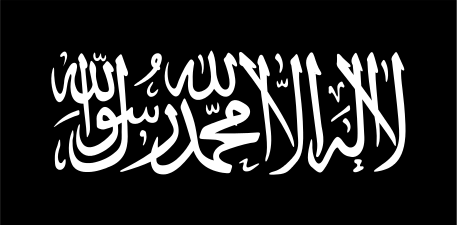Fidai Mahaz
| Fidai Mahaz (Sacrifice Front) | |
|---|---|
| Participant in the War in Afghanistan | |
|
Flag of Jihad | |
| Active | c. 2013–present[1] |
| Ideology | |
| Groups | Pashtuns |
| Leaders | Mullah Najibullah |
| Area of operations | |
| Strength | 8,000[1] |
| Originated as | Taliban and Mullah Dadullah Front |
| Opponents |
State opponents
|
| Battles and wars | |
| Website | http://www.allfida.org/en/ |
The Sacrifice Front, more commonly known as Fidai Mahaz, is a Taliban splinter group and faction in the War in Afghanistan. They are led by Mullah Najibullah, also known as Omar Khitab, a former Taliban commander.[2][1]
History
Foundation
Fidai Mahaz was formed by ex-Taliban members and former members of the Mullah Dadullah Front.[2] They had grown disillusioned with the leadership of the Taliban under Mullah Akhtar Mansour over peace talks with the Kabul government, opening a political office in Qatar and approaching Iran for support.[2][1]
The groups leader, Mullah Najibullah, stated that the groups aims were simple: Cancelling the peace process between the insurgents and the Afghan government, and continuing to fight the government in Kabul and the NATO forces until they have left Afghanistan.[1]
War in Afghanistan
Sources within Afghan intelligence and Taliban figures have stated that Fidai Mahaz was behind the failed suicide attack on the Indian Consulate in the eastern town of Jalalabad in early 2013.[1]
On 11 March 2014, Fidai Mahaz claimed responsibility for the killing of British-Swedish reporter Nils Horner. The groups spokesman, Qari Hamza, accused him of being "a spy of Mi6" in an English-language statement.[3]
Death of Mullah Omar
Fidai Mahaz claimed Taliban founder and former leader Mullah Mohammed Omar did not die of natural causes but was instead assassinated in a coup led by Mullah Akhtar Mansour and Mullah Gul Agha. The Taliban commander Mullah Mansoor Dadullah, brother of former senior commander Mullah Dadullah, also claimed that Omar had been assassinated.[4] Mullah Najibullah, claimed that due to Omar's kidney disease, he needed medicine. According to Najibullah, Mansour poisoned the medicine, damaging Omar's liver and causing him to grow weaker. When Omar summoned Mansour and other members of Omar's inner circle to hear his will, they discovered that Mansour was not to assume leadership of the Taliban. It was due to Mansour allegedly orchestrating "dishonourable deals". When Mansour pressed Omar to name him as his successor, Omar refused. Mansour then shot and killed Omar. Najibullah claimed Omar died at a southern Afghanistan hide-out in Zabul Province in the afternoon on 23 April, 2013.[5][2]
References
- 1 2 3 4 5 6 7 "Mullah Najibullah: Too Radical for the Taliban". Newsweek. 30 August 2013. Retrieved 22 August 2015.
- 1 2 3 4 "Why the Taliban murdered their own leader and the terrifying fallout now threatening the West". The Mirror. 21 August 2015. Retrieved 22 August 2015.
- ↑ "Taliban splinter group says it killed British-Swedish reporter Nils Horner". The Guardian. 13 March 2014. Retrieved 22 August 2015.
- ↑ "Pakistan exposed Mullah Omar's death for its own interests: Kandahar clerics". Khaama Press. 18 August 2015. Retrieved 22 August 2015.
- ↑ "Mullah Omar: a myth of convenience". The Hindu. 20 August 2015. Retrieved 22 August 2015.
